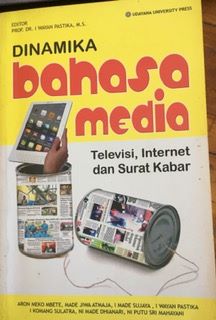
THE DYNAMICS OF MEDIA LANGUAGE: Television, Internet and Newspaper
I Wayan Pastika
ISBN : 978-602-7776-27-2 Published : 2013
Abstrak
THE DYNAMICS OF MEDIA LANGUAGE: Television, Internet and Newspaper
Editor:
I Wayan Pastika
Abstract
The quality of mass media is not just seen from the contents of the message or information delivered, but how they are packed to the public. Mass media that uses improper language event its messages is worthwhile, will be considered unqualified media. On the contrary, the media that is able to convey messages in a regular language: standard grammar, social etiquette, delivering clear and easy messages, be considered good media. However, in the past few years, specifically in Indonesia, television networking, radio and internet less accessible to the development of Indonesian identity. Media people pay less attention to linguistic non-sense and ignore politeness in engaging with the audience. Foreign languages, especially English is often mixed with Indonesian. In terms of politeness, we often hear harsh nuances in the form of curses, harassment and insults; while verbal and nonverbal languages that contain obscene are everywhere. All that is presented when school children take the time to watch television shows.
However, the development of Indonesian may not be separated from the positive role of mass media. One of them can be seen from the emergence of new vocabularies sourced from the Indonesian language. Words such as: canggih, nirlaba, dirumahsakitkan, dipolisikan, digadang, pengembang, keberlanjutan, tahun jamak, and dana talangan used by the mass media which are constantly growing rapidly. In terms of information delivery, the description of topics in the media should be delivered politely, fulfilling the rules of language, without losing its journalist characteristics: concise, concise, straightforward, simple, interesting, clear, and typographical. Media texts that are highly valued should be exhibited with the work of respectful editor. An editor is responsible for three aspects of the journalist's edited writings: language, presentation techniques, and news content or material. News must have the characteristics of journalism both public standards and internal standards relating to the style and peculiarities of the media received.